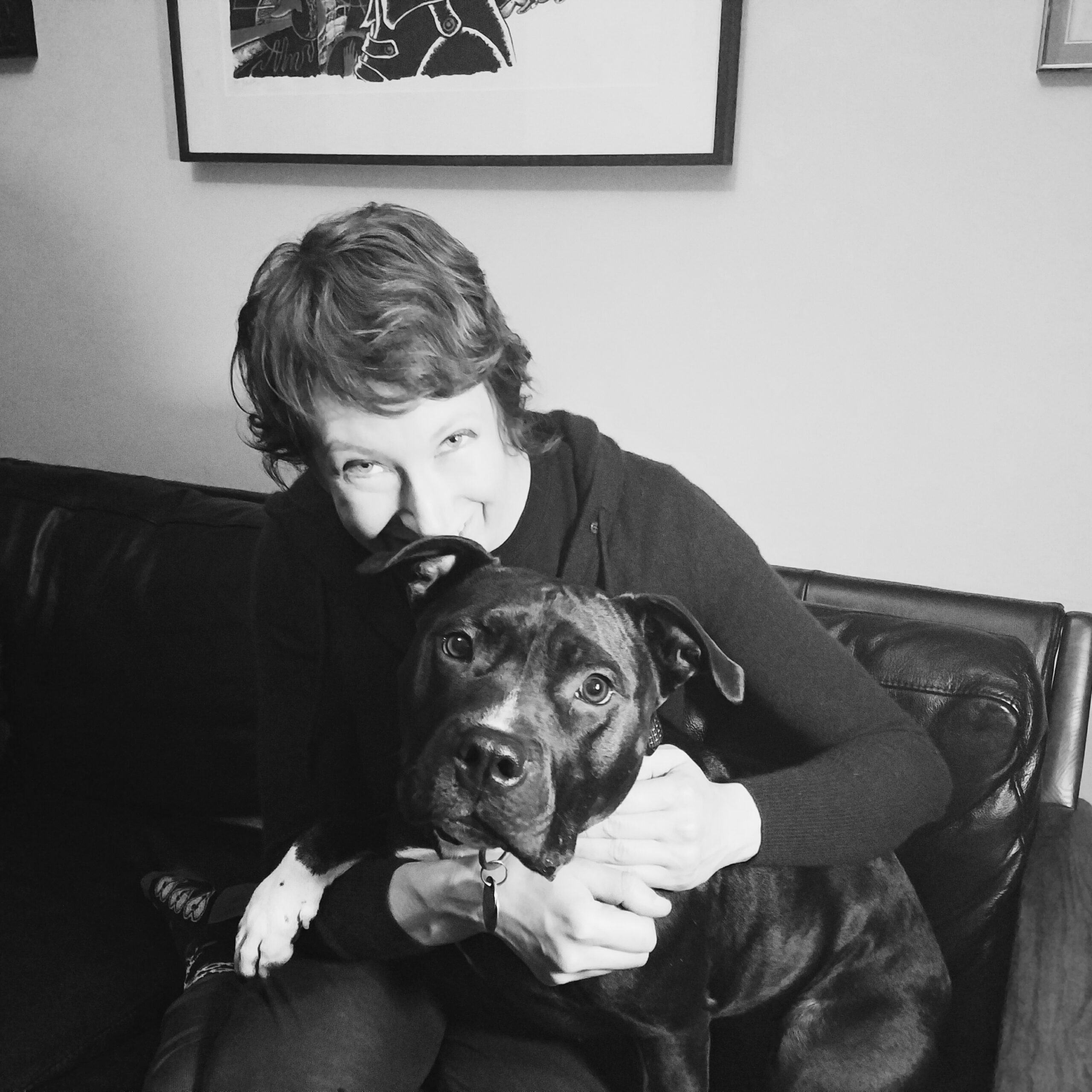Barks Blog
Portland Blog Competition: Canine Aggression – The Public Perception
By Hannah Blumenfeld

“Not a nice dog,” says the woman on the sidewalk. Lucy and I had just walked past her, and although I was shoving treats in Lucy’s mouth, the woman locked eyes with my beautiful beast. This scares the bejeezus out of Lucy, so she barks. And, yes, sometimes lunges. I do not correct the woman; I don’t tell her that Lucy is, in fact, a very nice dog.
A couple months earlier, we were walking past a family of four. First came the mom and older daughter. They both got what I call the “happy-doggy face.” The girl tells me that Lucy is cute. I say thank you, adding that Lucy does not enjoy attention from strangers, that it’s best to ignore her. Next come the dad and younger son. Dad is laughing, says, “yeah, yeah, ignore the doggy, okay.” He doesn’t take me seriously. Lucy’s had enough and barks at the boy, who literally cowers in fear. Terrible does not even begin to describe how I feel. Half a block away, the dad shouts back to me, “Ma’am? Ma’am? There are lots of families in this neighborhood, lots of children. That’s an aggressive dog you’ve got there. And we have dogs, we’re dog people.” I don’t tell him that I live on the block, that I know the neighborhood very well, thanks.
These are my most embarrassing stories, the ones that I retell to myself while playing the imposter game—you know, that’s where you say to yourself, “I can’t possibly be a dog trainer. If I can’t even control my own dog, how can I help anyone else?” In other words, I’m an imposter. I’m not really a dog trainer. I can’t—or shouldn’t—be. Lucy is an American Staffordshire terrier. I have watched tiny dogs react to people the same way Lucy does, and people both on the receiving end of such aggressive signaling and the owning end of such dogs laugh about it.
Nobody has ever, ever laughed about Lucy. She’s a very high-drive dog. She needs a job, a task, and until she gets one, she can be pretty hyperaroused, or beyond her frustration threshold. So when we’re at the river and someone has a ball, Lucy is silently alert at their feet, waiting for the ball to be thrown, the ultimate signal that, yes, she has a job to do! Sometimes, the human holding the ball stops throwing to say, “Oh my! What a pretty girl you are! Do you want this ball? Huh? Do you want me to throw this ball? Do you?” So Lucy barks, a high-pitched, insistent bark. Most people just throw the ball. But some will freeze. They’ll turn to me, say, “I don’t know what she wants.” Or, “Your dog is scaring me.”
I have watched countless other breeds do the exact behavior Lucy does at the river, and nobody ever acts scared. Is Lucy being aggressive? In this case, absolutely not. Here’s the thing. I know Lucy. And I am a dog trainer. I try very hard to manage our environment, to not take walks when there are likely to be many people out, to veer off the sidewalk into the street when we can. But sometimes we can’t; sometimes there’s a car (or seven) coming and there’s no driveway or other place to hang out and play obedience games while we wait for people to pass us. (This is how we ended up walking past the family of four.) So I ask people to ignore her, and when they listen to me, Lucy is fine. She focuses on me, on my treats, on heeling left and heeling right. When they don’t, either because they’re “dog people” or don’t take me seriously or who knows what, Lucy barks at them. And, yes, sometimes lunges.
I’ve considered putting a muzzle on her (not because I think she’ll bite, but because I think it might lead people to give us a wider berth). I’ve considered never taking her on walks (which is fine, we do agility and go on doggy adventures, she gets plenty of exercise—but we live in a building with no parking and we have to walk around the corner of our very busy street to get to our car, multiple times a day). I’ve considered moving to a neighborhood with less foot traffic (but I can’t afford to).
I have spent a lot of time watching how people interact with dogs they don’t know. A handsome boxer was tied up outside a shop, and a woman went right up to him, got in his face, like mere inches away, and told him what a good dog he was. The dog tolerated it. He kept peering past her, toward the shop his person was in. He was pointedly ignoring the woman, but she didn’t notice. A friend of mine was visiting an apartment where I was watching a very old, very scared, very tiny dog. When she was leaving, she stood at the door for a while and stared at the ancient Chihuahua and said goodbye to him about four times. He was literally frozen where he was, unable to move, but my friend didn’t notice.
Dogs tolerate so much human behavior even when it makes them uncomfortable. When a dog expresses his discomfort, he’s “not a nice dog.” An aggressive dog, even. I’m already anxiously anticipating all sorts of harsh reactions to this piece. “You should’ve turned around when you saw that family and couldn’t walk into the street to pass them.” Yes, yes, I should have. “You should do more counterconditioning and desensitization.” Well, okay, I do that. But because we have to walk down our very busy street constantly, management is where it’s at. We can play engage-disengage until the cows come home, but living where we do means it’s one step forward, four steps back as far as keeping Lucy below fear level.
“People’s safety is paramount, and if your dog threatens people, then whether it’s provoked or not, your dog should not be in public.” I hear you, I do. And that’s why I try my best to manage Lucy’s interactions so everyone stays (and feels) safe. But here’s how I see it: If I ask you to please ignore my dog, and you don’t, then please don’t get angry with me when she barks at you. I don’t expect the world to revolve around me and Lucy, but I don’t think it revolves around you, either. When Lucy is off leash, she avoids people. She makes the right choice every single time. Even when people reach out to touch her, she moves away from them, her ears flattened. She really just wants to be left alone, to be ignored, and off leash she can make that happen. On leash, if I’m unable to manage her environment well enough, she barks to tell people to leave her alone.
I’m lucky—Lucy is seriously awesome with other dogs. But the same behavior is reflected in dog-aggressive dogs. I have been working with a small reactive terrier for a while now, and—surprise, surprise—the behavior is the same. Given appropriate distance, this dog would much rather play training games with me than yell at another dog. As the distance decreases, he becomes less interested in playing with me and more interested in yelling at “Danger Dog.” And if I lure him away so the distance increases, I can almost see him breathing a sigh of relief as he resumes working with me for treats. It’s not that he likes yelling at the other dogs. They scare him, and he wants them to go away. Okay. So all of this may be common knowledge to you, the dog-savvy reader. But my point is that popular knowledge of dogs often seems to run counter to actual dog behavior.
I don’t know how to change popular knowledge, but I wish I did. I tell people that staring at unknown dogs is like mad-dogging (err, that means staring, and hard) someone you pass on the street. So, canine aggression. Can we rebrand this? Almost always, by the time aggressive signaling happens, the dog has already indicated his discomfort in a number of subtler ways. And aggressive signaling itself does not mean that a dog is going to attack. It actually means the dog is trying, sometimes desperately, to avoid physical conflict. So how do we change the public’s perception of this? Should a dog that uses warning signals be considered an aggressive dog? I’ll take my answer off the air.
*This post is a runner up in our Portland 2019 Writers’ Competition. All winning and runner up entries will be published in the March 2019 issue of BARKS from the Guild. To learn more about canine and feline aggression, join us at the Pet Professional Guild Canine Aggression and Bite Prevention Educational Seminar (with bonus feline specialty track) in Portland, Oregon April 26-28, 2019.*
About the Author
Hannah Blumenfeld grew up in Dayton, Ohio, in a family of cat lovers. After 14 glorious years with her own feline soul-mate, she decided to switch teams and began volunteering in the dog kennels at Multnomah County Animal Shelter, where she fell in love with a Staffordshire terrier named Lucy. Together, they launched into extensive obedience training, earning their CGC in the process, and canine sports, including agility, rally obedience, flyball, and even sled-pulling. At Lucy’s side, Hannah quickly found a true passion in dog training. She is especially interested in the way humans misinterpret and misrepresent canine behavior and in integrating dog training into everyday life. She works as a trainer for Dog Adventures Northwest taking groups of dogs on off-leash pack hikes and leading private training sessions, attends Whole Dog Academy’s year-long canine behavior/dog training program, and will take the CPDT-KA exam in spring 2019.


